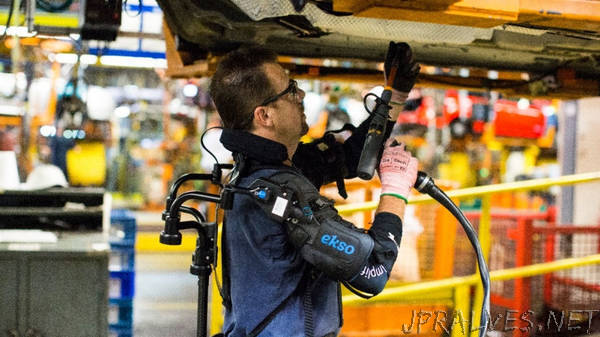
“Called EksoVest, the wearable technology elevates and supports a worker’s arms while performing overhead tasks.
- Ford assembly line workers are testing new upper body exoskeletal technology – EksoVest – that helps lessen the chance of fatigue or injury while performing overhead tasks
- EksoVest is the latest example of advanced technology Ford is using to reduce the physical toll on employees during the vehicle assembly process
- Since 2005, incidents in Ford’s North America facilities that resulted in time away from the job fell 83 percent; the 2016 incident rate was the lowest on record
Putting dishes on a high shelf or changing an overhead lightbulb occasionally might not be difficult, but could you imagine performing either of these tasks 4,600 times per day? How about 1 million times a year?
These are the approximate number of times some Ford assembly line workers lift their arms during overhead work tasks. At this rate, the possibility of fatigue or injury on the body increases significantly. But a new upper body exoskeletal tool – the result of a partnership between Ford and California-based Ekso Bionics – helps lessen the chance of injury.
“My job entails working over my head, so when I get home my back, neck and shoulders usually hurt,” said Paul Collins, an assembly line worker at Ford’s Michigan Assembly Plant. “Since I started using the vest, I’m not as sore, and I have more energy to play with my grandsons when I get home.”
Called EksoVest, the wearable technology elevates and supports a worker’s arms while performing overhead tasks. It can be fitted to support workers ranging from 5 feet tall to 6 feet 4 inches tall, and provides adjustable lift assistance of five pounds to 15 pounds per arm. It’s comfortable to wear because it’s lightweight, it isn’t bulky, and it allows workers to move their arms freely.
Designed and built for dynamic, real-world environments like factories, construction sites and distribution centers, the non-powered vest offers protection and support against fatigue and injury by reducing the stress and strain of high-frequency, long-duration activities that can take a toll on the body over time.
“Collaboratively working with Ford enabled us to test and refine early prototypes of the EksoVest based on insights directly from their production line workers,” said Russ Angold, co-founder and chief technology officer of Ekso Bionics. “The end result is a wearable tool that reduces the strain on a worker’s body, reducing the likelihood of injury, and helping them feel better at the end of the day – increasing both productivity and morale.”
With support from the United Automobile Workers and Ford, EksoVest is being piloted in two U.S. plants, with plans to test in other regions, including Europe and South America.
“The health and safety of our membership has always been our highest priority,” said UAW-Ford Vice President Jimmy Settles. “With the proven success at the piloted locations, we look forward to expanding this technology to our other UAW-Ford manufacturing facilities.”
EksoVest is the latest example of advanced technology Ford is using to reduce the physical toll on employees during the vehicle assembly process. Between 2005 and 2016, the most recent full year of data, the company saw an 83 percent decrease in the number of incidents that resulted in days away, work restrictions or job transfers – to an all-time low of 1.55 incidents per 100 full-time North American employees.
“Our goal has always been to keep the work environment safe and productive for the hardworking men and women we rely on across the globe,” said Bruce Hettle, Ford group vice president, Manufacturing and Labor Affairs. “Investing in the latest ergonomics research, assembly improvements and lift-assist technologies has helped us design efficient and safe assembly lines, while maintaining high vehicle quality for our customers.”
To date, Ford ergonomists have worked on more than 100 new vehicle launches globally using ergonomic technology tools, including most recently the 2018 Ford Mustang, 2018 Ford F-150, and the all-new 2018 Ford Expedition and 2018 Lincoln Navigator. Through significant investments in the program, not only has Ford achieved a reduction in employee incident rates, it has seen a 90 percent decrease in such ergonomic issues as overextended movements, difficult hand clearance and tasks involving hard-to-install parts.”
